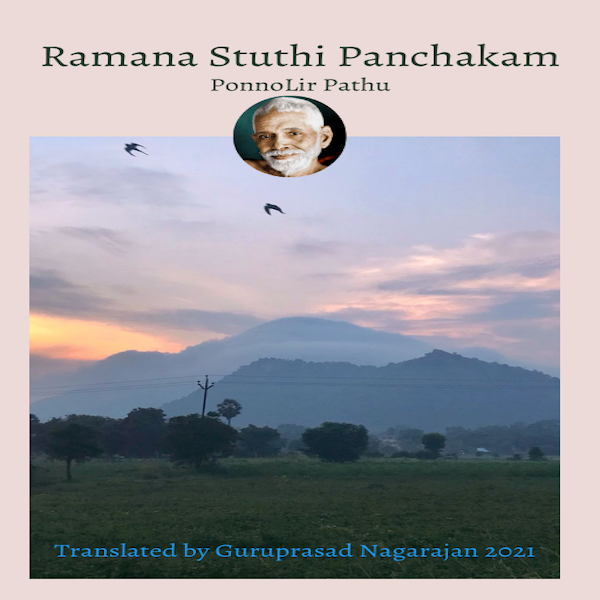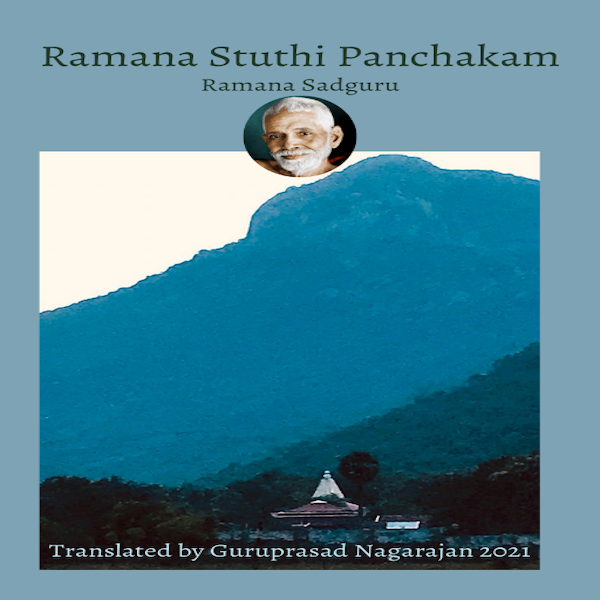Dhevar yaavarum vandhu nindru
Thudhithidum padha vaibhavan;
Kaavalaagi mei gnana naat ara
Saagi nindridu kaaraNan.
Word meaning
dhevar = celestials; thudhi = to worship; vaibhava = grandeur; kaaval = to guard, protect; mei gnanam = truth knowledge; arasu = kingdom, domain; kaaraNam = cause.
Meaning
Our Ramana has many great attributes that draw even the celestials to come and worship him. He is the guardian of his devotees. He is the ruler of the kingdom of Truth, he is also the root cause of it.
Bhagavan’s divinity has been vouchsafed by many devotees who saw their favourite deities in him and also were blessed with the darshan of Formlessness. Ganapati Muni records two incidents when he was with Bhagavan which serve to corroborate what SV states in the first line.
(from At the Feet of Bhagavan)
Sri Bhagavan was in the Virupaksha Cave on the Hill. One evening after 7 p.m., they were all coming down the Hill to go round Arunachala. The other devotees had all gone in advance; only Sri Kavyakanta Ganapati Muni was in the company of Sri Maharshi, and they were slowly climbing down the steps from the cave. When they had walked a few steps, all of a sudden Sri Maharshi stopped, and with Him Sri Kavyakanta as well. The full moon was shining bright in the starry sky. Pointing to the moon and the beautiful sky, Sri Bhagavan said: “Nayana! if the moon, and all the stars have their being in ME, and the sun himself goes round My hip with his satellites, who am I? Who am I?”
And on another occasion:
Early one morning he (Ganapati Muni) saw a bright light appear and touch Bhagavan’s forehead. The light enveloped Bhagavan, and within that glowing effulgence Ganapati Muni discerned six stars of different colours which eventually merged into a single light.
Ranga, another devotee, recollects (from ‘Devotees’ book):
Once, while he was reading the Ribhu Gita, he looked up and remarked, ‘The trimurtis [the three gods, Brahma, Vishnu, and Siva] stand before the jnanis with folded hands, saying, “I am at your service”. The trimurtis have the work of uplifting the world, but jnanis do not even have that responsibility.’
Bhagavan once gave us an example of the Gods serving jnanis when he told us about an encounter he had on the hill. He had been wandering aimlessly on the mountain, without food, when an old woman brought some rice gruel in a pot and gave it to him.
Bhagavan, who could easily discern spiritual greatness in the most ordinary-looking people, told us, ‘I thought that she must have been Mother Parvati herself.’
About a mongoose that came to Skandashram, Bhagavan said to Mastan Swami: “This was a sage of Arunachala who took on this form to come and visit me. He wanted to pay his respects to me. How many times have I told you that sages come to see me in various forms?”
There are many incidents where Bhagavan has protected his devotees from various types of dangers.
Ranga, again, had been predicted to have a very rough year in 1921, and Bhagavan gave him strict orders on his movement which was very unusual. After spending a year in Bhagavan’s presence, he went back home.
Another incident involves Sampurnamma, an ashram cook and another ashram kitchen worker, who felt unsafe going back home from the ashram as it was surrounded by the jungle. She says:
“After walking a while, we saw a strange, blue light in front of us. It was uncanny and we thought it was a ghost, but it led us along the path. When we realised it was guiding us, we felt safe with it. It left us at dawn.Another time the the two of us were walking around the hill early in the morning and chattering about our homes and relatives. We noticed a man following us at a distance. We had to pass through a stretch of lonely forest, so we stopped to let him pass and go ahead. He too stopped. When we walked, he also walked. We got quite alarmed, and started praying aloud, ‘Lord Arunachala! Only you can help us, only you can save us!’ The man caught up with us and remarked, ‘Yes, Arunachala is our only refuge. Keep your mind on him constantly”
Thudhithidum padha vaibhavan;
Kaavalaagi mei gnana naat ara
Saagi nindridu kaaraNan.
Word meaning
dhevar = celestials; thudhi = to worship; vaibhava = grandeur; kaaval = to guard, protect; mei gnanam = truth knowledge; arasu = kingdom, domain; kaaraNam = cause.
Meaning
Our Ramana has many great attributes that draw even the celestials to come and worship him. He is the guardian of his devotees. He is the ruler of the kingdom of Truth, he is also the root cause of it.
Bhagavan’s divinity has been vouchsafed by many devotees who saw their favourite deities in him and also were blessed with the darshan of Formlessness. Ganapati Muni records two incidents when he was with Bhagavan which serve to corroborate what SV states in the first line.
(from At the Feet of Bhagavan)
Sri Bhagavan was in the Virupaksha Cave on the Hill. One evening after 7 p.m., they were all coming down the Hill to go round Arunachala. The other devotees had all gone in advance; only Sri Kavyakanta Ganapati Muni was in the company of Sri Maharshi, and they were slowly climbing down the steps from the cave. When they had walked a few steps, all of a sudden Sri Maharshi stopped, and with Him Sri Kavyakanta as well. The full moon was shining bright in the starry sky. Pointing to the moon and the beautiful sky, Sri Bhagavan said: “Nayana! if the moon, and all the stars have their being in ME, and the sun himself goes round My hip with his satellites, who am I? Who am I?”
And on another occasion:
Early one morning he (Ganapati Muni) saw a bright light appear and touch Bhagavan’s forehead. The light enveloped Bhagavan, and within that glowing effulgence Ganapati Muni discerned six stars of different colours which eventually merged into a single light.
Ranga, another devotee, recollects (from ‘Devotees’ book):
Once, while he was reading the Ribhu Gita, he looked up and remarked, ‘The trimurtis [the three gods, Brahma, Vishnu, and Siva] stand before the jnanis with folded hands, saying, “I am at your service”. The trimurtis have the work of uplifting the world, but jnanis do not even have that responsibility.’
Bhagavan once gave us an example of the Gods serving jnanis when he told us about an encounter he had on the hill. He had been wandering aimlessly on the mountain, without food, when an old woman brought some rice gruel in a pot and gave it to him.
Bhagavan, who could easily discern spiritual greatness in the most ordinary-looking people, told us, ‘I thought that she must have been Mother Parvati herself.’
About a mongoose that came to Skandashram, Bhagavan said to Mastan Swami: “This was a sage of Arunachala who took on this form to come and visit me. He wanted to pay his respects to me. How many times have I told you that sages come to see me in various forms?”
There are many incidents where Bhagavan has protected his devotees from various types of dangers.
Ranga, again, had been predicted to have a very rough year in 1921, and Bhagavan gave him strict orders on his movement which was very unusual. After spending a year in Bhagavan’s presence, he went back home.
Another incident involves Sampurnamma, an ashram cook and another ashram kitchen worker, who felt unsafe going back home from the ashram as it was surrounded by the jungle. She says:
“After walking a while, we saw a strange, blue light in front of us. It was uncanny and we thought it was a ghost, but it led us along the path. When we realised it was guiding us, we felt safe with it. It left us at dawn.Another time the the two of us were walking around the hill early in the morning and chattering about our homes and relatives. We noticed a man following us at a distance. We had to pass through a stretch of lonely forest, so we stopped to let him pass and go ahead. He too stopped. When we walked, he also walked. We got quite alarmed, and started praying aloud, ‘Lord Arunachala! Only you can help us, only you can save us!’ The man caught up with us and remarked, ‘Yes, Arunachala is our only refuge. Keep your mind on him constantly”







 RSS Feed
RSS Feed